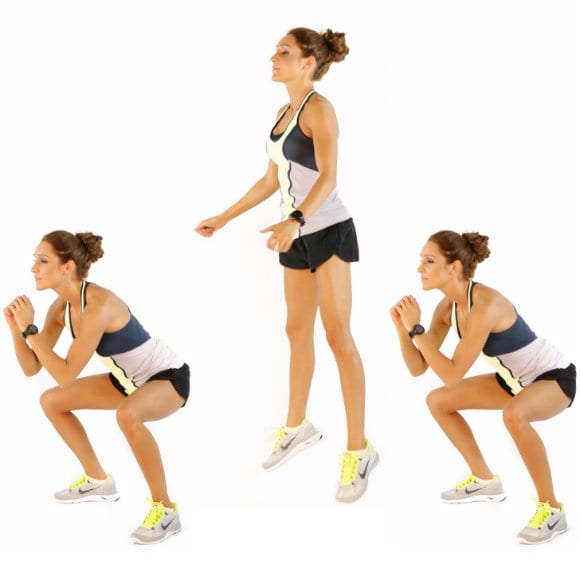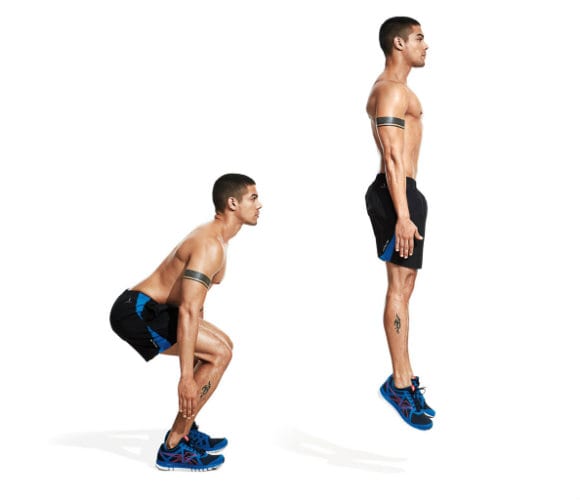By the healthiergang writer , personal trainer.
Jump squat
The lower limbs are, for us, very important as humans are among the few living beings who move almost exclusively in an upright position.
For this reason, some of the strongest muscles and ligaments are those of the thigh (such as gluteus maximus, ileofemoral ligament or quadriceps muscle complex).
Anatomical Notes
It must also be remembered that the lower limbs are made up of innumerable muscles that collaborate synergistically in the various movement functions and that for optimal training it is recommended to train by combining basic (multi-joint) exercises with complementary (single-joint) or more specific exercises.
The main muscles that make up the lower limbs are:
- buttock: small, medium, large
- quadriceps: vast external, internal, rectus femoris
- tailoring
- puny
- comb
- adductor: large, long, short
- tensor fascia lata
- ischiotibialis: hamstring, semitendinosus, semimembranous
- twins (calves)
- psoas iliaco
For the last muscle listed, it should be remembered that an excess of muscle tone can lead to lumbar hyperlordosis resulting in back pain and a higher incidence of pathologies such as herniated discs, protusions, etc.
There are countless exercises and numerous variations to train the lower limbs.
In this article we go to deepen a variant of the Squat, or the Jump Squat.
Performing the Jump Squat
The muscles mainly involved in this exercise are: quadriceps, gluteus maximus (in a secondary way also ischiotibialis, adductors, gastrocnemas and lumbar).

For a correct execution:
- stand upright, legs shoulder width apart; arms extended forward.
- bend your legs and descend, controlling the movement, until you reach a complete squat.
- once in this position jump explosively upwards, with the help of a slight movement of the arms;
- cushion the arrival phase with your legs (it is very important not to land with the full sole of the foot or on the heel; to cushion correctly, land first on the tip of the foot then move on to place the sole first and then the heel).
Benefits
In many cases the jump squat is considered an exercise that leads to back pain, especially with the addition of a barbell or load.
It must be said, however, that if the load is positioned in the wrong place or if you assume incorrect positions, you will have a greater overload of the spine and the joints of the lower limbs.
This exercise turns out, however, to be very effective in that allows the work of the hip extensor chain, both in the flexion-extension action and in the propulsion action (due precisely to the jump); in addition, it is great for improving explosive strength and fast strength.
How to enter it?
The important thing before incorporating the jump squat into a training routine is:
- learn the correct execution of the classic squat, starting with free body;
- learn the correct positions, i.e. knees aligned that do not converge inwards or outwards, knees that do not exceed the line of the feet excessively (this could cause damage to the knees), torso erect while maintaining physiological curvatures

- then move on to the use of preparatory exercises for the various muscle groups stressed in the jump squat, i.e. lower limbs, spine and back muscles.
- with the use of reduced loads, position the tools at the front, elbows high; this reduces the load on the lower back
- cushion the landing well in order to reduce the load on the joints of the lower limbs.
Mistakes
The most mistakes made when performing this exercise are:
- bring your knees in or out, especially on landing
- flex the torso forward to aid execution, accentuating the load on the back
- bring the knees forward, overloading the joint
- perform a half movement with the legs
- bring the buttock back too far, unbalancing the body.
variants
Variations to the classic Jump Squat can be:
- asymmetrical jump squat: with one leg slightly forward than the other
- overhead jump squat
- jump squat con sangbag
- jump squat su cubo box
- jump squat con medball
Conclusions
In conclusion, to recap, a balanced workout must not neglect any of the muscles that make up the lower limbs and for this reason it is necessary to insert multi-joint exercises. Simple extensions or push-ups will leave out the work of most of the muscles.
Stretching is also very important, as it allows you to keep the joints and especially the knee healthy.


























